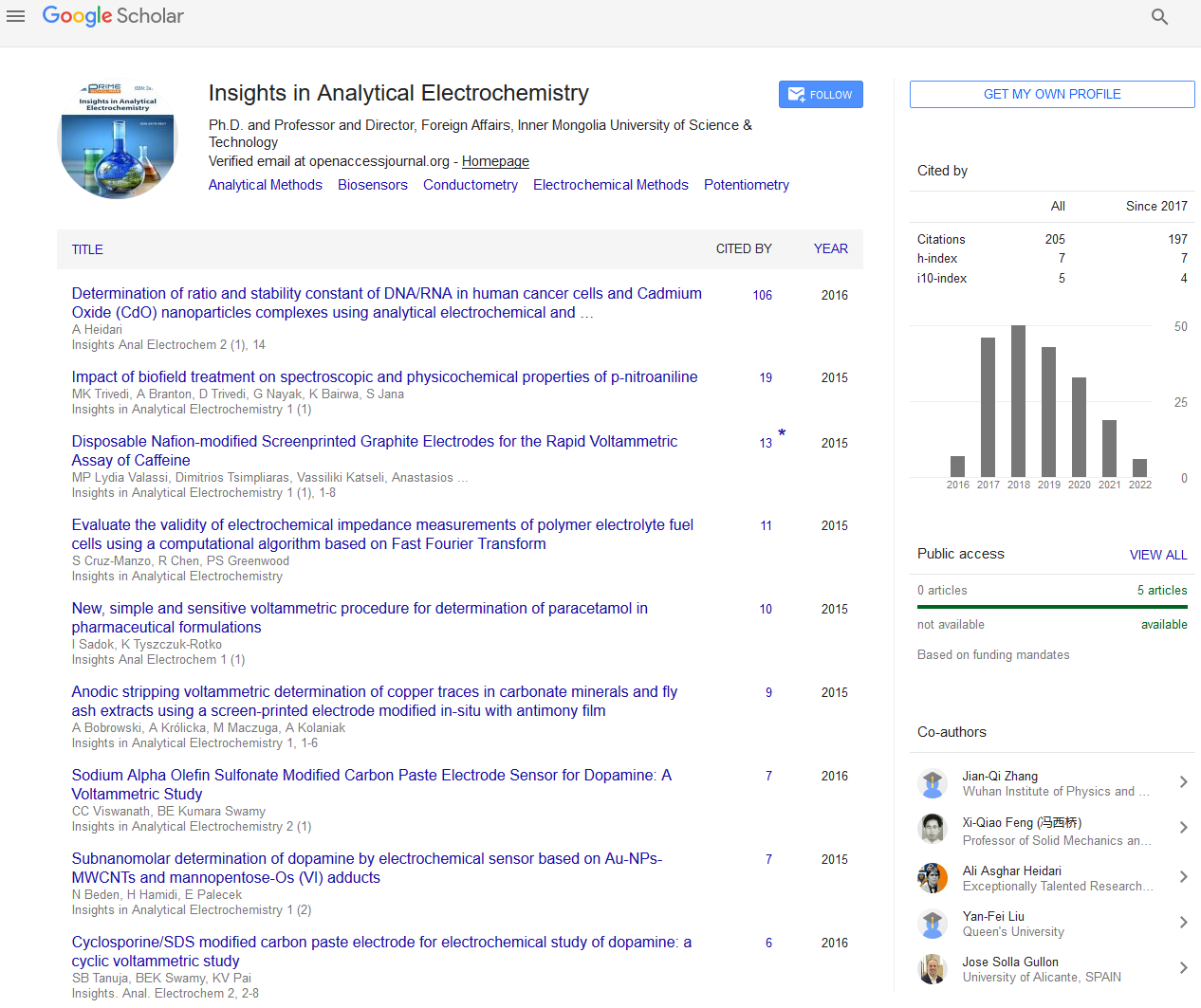Opinion - (2024) Volume 10, Issue 2
Key Electrochemical Techniques and Their Applications
Akira Ren*
Department of Chemistry, Nihon University, Japan
*Correspondence:
Akira Ren,
Department of Chemistry, Nihon University,
Japan,
Email:
Received: 29-May-2024, Manuscript No. IPAEI-24-20790;
Editor assigned: 31-May-2024, Pre QC No. IPAEI-24-20790 (PQ);
Reviewed: 14-Jun-2024, QC No. IPAEI-24-20790;
Revised: 19-Jun-2024, Manuscript No. IPAEI-24-20790 (R);
Published:
26-Jun-2024, DOI: 10.36648/2470-9867.24.10.15
Introduction
Electrochemistry is the branch of chemistry that studies the
relationship between electricity and chemical reactions. It
has wide-ranging applications, from batteries and fuel cells
to electroplating and corrosion prevention. The methods
used in electrochemistry are crucial for understanding
these processes and designing efficient systems. This article
outlines some of the primary electrochemical methods
potentiometry, voltammetry, and Electrochemical Impedance
Spectroscopy (EIS). Potentiometry measures the voltage of
an electrochemical cell without drawing significant current. It
is based on the Nernst equation, which relates the electrode
potential to the concentration of ions. This method is widely
used in pH measurement, ion-selective electrodes, and redox
titrations. In potentiometry, a reference electrode with a
known and stable potential is used alongside an indicator
electrode, whose potential varies with the concentration of
the analyte. The potential difference between these electrodes
is measured, allowing the determination of ion concentration
in the solution. Modern potentiometric methods involve
automated systems with high precision and sensitivity, suitable
for a variety of analytical applications.
Description
Voltammetry involves measuring the current that flows in
an electrochemical cell as the potential is varied. It provides
insights into the redox behaviour of analytes and the kinetics of
electrochemical reactions. Different voltammetric techniques
include Cyclic Voltammetry (CV), Linear Sweep Voltammetry
(LSV), and Differential Pulse Voltammetry (DPV). In CV, the
potential is swept cyclically between two values, providing
a current-potential curve that reveals information about
redox potentials and reaction mechanisms. It is especially
useful for studying reversible redox systems and the electron
transfer kinetics of compounds. In LSV, the potential is linearly
increased over time. This technique helps in understanding the
electrochemical behavior of an analyte over a wide range of
potentials, often used for the detection and analysis of trace
metals. DPV superimposes a series of voltage pulses on a
linear potential ramp. It enhances sensitivity and resolution by
focusing on the difference in current response before and after
each pulse, making it ideal for detecting low concentrations
of analytes. EIS is a powerful technique for characterizing the
electrical properties of materials and interfaces. It measures
the impedance of an electrochemical cell over a range of
frequencies, providing detailed information about resistance,
capacitance, and inductance within the system. The data
obtained from EIS are often represented in Nyquist or Bode
plots. Analytical electrochemistry unveils precise methods to
detect and quantify substances down to minute concentrations.
Conclusion
Miniaturization and the development of microelectrodes
have opened new possibilities in studying electrochemical
processes at the micro scale, enhancing sensitivity and
enabling in situ measurements. Electrochemical methods such
as potentiometry, voltammetry, and EIS are indispensable
tools in both research and industrial applications. They
provide detailed insights into chemical processes and help in
the development of advanced materials and technologies. As
these methods continue to evolve, they will undoubtedly play a
crucial role in addressing future scientific and technological. As
these techniques advance, the integration of machine learning
and artificial intelligence is expected to further enhance data
interpretation and predictive capabilities. The continued
development and refinement of electrochemical methods
will be pivotal in driving innovations in sustainable energy,
environmental protection, and healthcare diagnostics.
Acknowledgement
None.
Conflict Of Interest
The author’s declared that they have no conflict of interest.
Citation: Ren A (2024) Key Electrochemical Techniques and their Applications. Insights Anal Electrochem. 10:15.
Copyright: © 2024 Ren A. This is an open-access article distributed under the terms of the Creative Commons Attribution License, which permits unrestricted use, distribution, and reproduction in any medium, provided the original author and source are credited.

